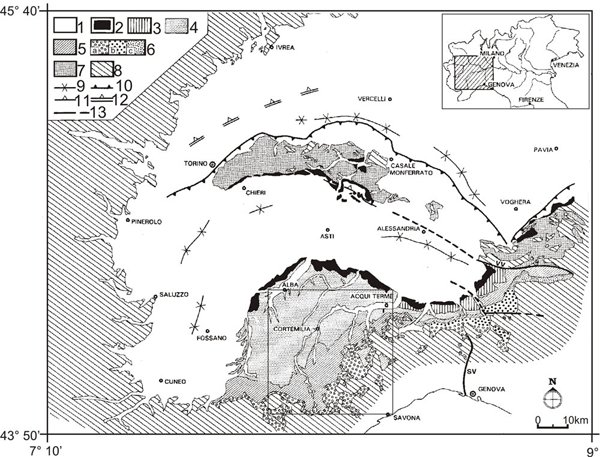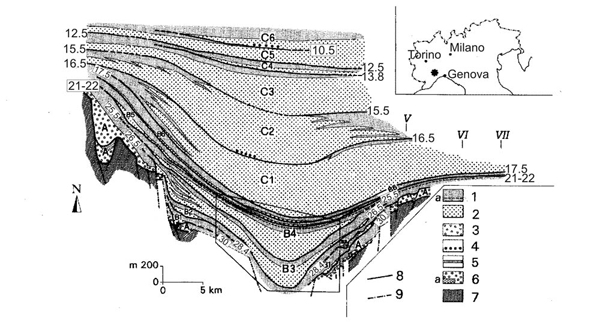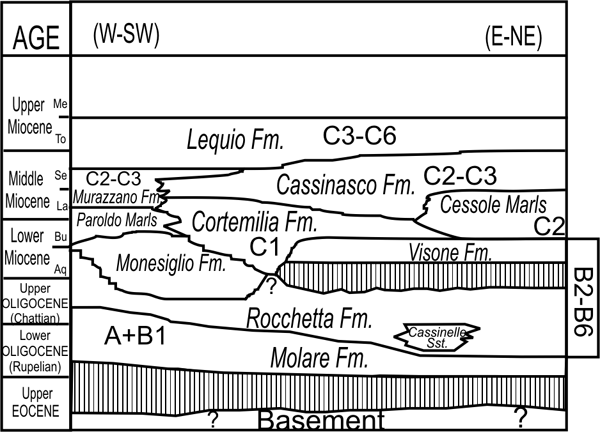Although the Alpine chain has been widely studied, many ongoing issues regarding the timing of the poly-metamorphic history, the pattern of exhumation and the possible effects of a Cretaceous high-pressure (HP) metamorphic event are still strongly debated (England and Molnar, 1990; Rubatto and Hermann, 2001). For instance, several authors have dismissed the Cretaceous signal and have attributed ages ranging around 80-120 Ma (from 40Ar/39Ar dating on white micas) to incorporation of excess 40Ar (e.g. Arnaud and Kelley, 1995; Reddy et al., 1996). For this reason recent paleogeographic reconstructions suggest that subduction, leading to high pressure and ultrahigh pressure metamorphism in the Alpine orogen, occurred no earlier than Late Cretaceous time (e.g. Agard et al., 2002; Reddy et al., 2003) and dismiss the possibility of an older history preceding this. However, regardless of any isotopic constraint, the only upper limit of the oceanic domain and lower limit for the onset of the subduction is given by the presence of Callovian-Oxfordian (~165-154 Ma) Alpine/Apennine supra-ophiolitic sediments (e.g. Wever et al., 1987), which leaves room for interpretations that invoke a more extended Cretaceous metamorphic history for the Western Alps. The purpose of this paper is to investigate the validity of Cretaceous events by looking at the geochronological signal recorded by clastic sediments derived by the erosion of the Western Alpine orogen.
Continuing exhumation and erosion prevent us from assessing the rock record in orogenic belts at any time before the present. This record is available, however, in the form of sediments in syn-orogenic clastic sedimentary basins such as the Tertiary Piedmont Basin (TPB). Thus, constraints on processes of cooling and exhumation of the orogen can be obtained from sediment petrography. In this context detrital mineral geochronology is a unique technique because it provides quantitative information on cooling/exhumation and erosion events in the surrounding orogen as it develops through time.
The TPB (Figure 1), located within the Internal Western Alpine Arc, is one of the main sedimentary basins collecting the products of the cooling/exhumation and subsequent erosion of Western Alpine rocks over the last ca. 30 Myr (Carrapa, 2003c and references therein). Oligocene sediments deposited in the TPB are derived mainly from the Ligurian Alps to the south (Barbieri et al., 2003), while Miocene sediments are derived from western-north-western Alpine rocks including the Internal Western Alpine Massifs and possibly the Sesia Lanzo zone (Carrapa et al., 2003c). 40Ar/39Ar analysis on detrital white micas has been performed on samples from the entire TPB clastic sequence ranging from Late Eocene – Present, providing a complex picture of age signals caused by cooling/exhumation events. In this paper the discussion will focus on the importance of the Cretaceous ages and we refer to Carrapa (2002) for discussion of other facets of the database.
The Tertiary Piedmont Basin (TPB) is located within the Internal Western Alpine Arc at the junction of the Alpine and the Apennine thrust belts sealing at present their tectonic relationships (Figure 1). From Late Eocene-Early Oligocene until Late Miocene times the TPB accommodated sediments from the erosion of the surrounding source areas (Internal Western Alps). The TPB is bounded to the south by the Ligurian Alps (including the Voltri Group), which form the easternmost segment of the Western Alpine Arc, to the west by the rest of the Western Alpine domain, to the north and north-east by the Po Plain and to the east by the Northern Apennine (Figure 1).
Figure 1. Tectonic map of the Alps

Tectonic map of the Alps showing the major nappe complexes (the Austro-Alpine, the Penninic with the Ophiolitic domain and the Helvetic), modified from Bigi et al. (1983). AGM: Argentera Massif, DM: Dora Maira, GP: Gran Paradiso. Square: study area.
In the study area the clastic sequence contains up to 4 km Oligocene-Upper Miocene sediments (Figure 2a, 2b, 2c). Subsidence in the TPB started in the latest Eocene-Early Oligocene and caused the progressive drowning of the Ligurian Alps. The onset of sediment deposition occurred mostly in the Early Oligocene (Dela Pierre et al., 1995). Sedimentation continued until Late Miocene time with strong subsidence during the Langhian (Carrapa et al., 2003a; Gelati et al., 1993) followed by recent uplift (e.g. Lorenz, 1984) allowing the entire stratigraphic series to crop out at present.
Figure 2a. Geological framework of the study area

Geological framework of the study area modified after Gnaccolini et al. (1998). 1) Pliocene to Recent deposits; 2) Messinian deposits; 3) Langhian to Tortonian siliciclastics and carbonates shelf to slope deposits; 4) Late Burdigalian to Tortonian mainly turbidite succession (only Burdigalian in the eastern sector of the figure); 5) Late Oligocene to Burdigalian turbidite systems and hemipelagic mudstones; 6) Late Eocene to Early Oligocene deposits: (a) alluvial to coastal conglomerates, shallow marine sandstones and hemipelagic mudstones, (b) slope and base-of-slope, resedimented conglomerates and (c) mainly turbidites; 7) Late Eocene to Tortonian siliciclastic deposits of the northwestern Apennines-Monferrato-Torino Hill wedge; 8) Alpine and Apennine allochthonous units; 9) depocentre axis of the Plio-Quaternary basins; 10) buried thrust-front of the Torino Hill-Monferrato-northwestern Apennine wedge; 11) buried, southvergent backthrusts of the Monferrato, active from Messinian onward; 12) buried, pre Burdigalian backthrusts of the Western Alps (as inferred from Roure et al. 1990; 13) faults: SV Sestri-Voltaggio, VVL Villalvernia-Varzi line. I: Bagnasco-Ceva-Bastia Mondoviʼ transect; II: Millesimo-Monesiglio-Somano transect; III: Dego-Torre Bormida-Alberetto della Torre transect; IV: Spigno Monferrato-Cessole transect; V: Montechiaro dʼAcqui; VI: Cavatore; VII: Visone. The square corresponds to the area of the paleocurrent study.
Figure 2b. Oligo-Miocene depositional sequences

Oligo-Miocene depositional sequences (A, B1-B6, C1-C6) in the study area modified after Gelati et al. (1993). 1: mudstones, locally with thin-bedded turbidites (a); 2: turbidite systems (sand/mud ratio from very high to = 1; locally conglomerates); 3: resedimented ophiolite breccia; 4: olistolith-bearing pebbly mudstones; 5: shallow-water carbonates; 6: alluvial conglomerates, coastal sandstones and conglomerates, fresh-water mudstones (a); 7: Pre-Cenozoic rocks; 8: sequence boundary; 9: fault. The area into the square is mainly based on Cazzola et al. (1981), Cazzola & Sgavetti (1984) and Cazzola & Fornaciari (1990). The ages of the unconformities/sequence boundaries are based on planktonic foraminifers and calcareous nannofossils and are referred to the correlation with the boundaries (Ma) of the third order global cycles of Haq et al. (1988).
The first sediments deposited in the study area are of alluvial and near-shore environmental settings (i.e. the Molare Formation) (Lorenz, 1979; Lorenz, 1984; Gelati et al., 1993; Gelati and Gnaccolini, 1996; Gelati and Gnaccolini, 1998; Mutti et al., 1999). Petrographical, geochronological and sedimentological analyses of the Molare Fm. indicate a provenance of these sediments from southern areas (Ligurian Alps; e.g. Gnaccolini, 1974; Barbieri et al., 2003 and references therein). At the end of the Early Oligocene, an increase of subsidence (Dela Pierre et al., 1995) occurred coevally with the deposition of a transitional/shallow marine marly/sandy sequence known as the Rocchetta Formation (Upper Oligocene-Aquitanian; Artoni et al., 1999; Gelati and Gnaccolini, 1996; Mutti, 1985 and references therein). The contact between the Molare Fm. and the Rocchetta Fm. is progressively younger from NE to SW (e.g. Fravega et al., 1994; Gelati et al., 1993; Vannucci et al., 1997).
The Early-Middle Miocene was generally characterised by more widespread basinal conditions (e.g. Gelati et al., 1993) and the deposition of hemipelagic sediments. The entire central area was characterised by silty/sandy sequences within which several different depositional bodies can be distinguished on the basis of the silt/ sand ratio (Rocchetta-Monesiglio Group; Cortemilia and Paroldo Fms.; Gelati and Gnaccolini, 1998; Gnaccolini et al., 1990). Petrographic and geochronological data together with paleocurrent directions indicate a contribution from western Alpine rocks to these sediments (Gnaccolini and Rossi, 1994; Carrapa, 2002).
During the Middle-Late Miocene different formations developed in the TPB. The eastern part of the TPB was characterised by shallow-water shelf sedimentation (Caprara et al., 1985; Ghibaudo et al., 1985) while basinal conditions prevailed elsewhere. This allowed the deposition of tabular turbidites and interbedded hemipelagites constituting the Murazzano Fm., the Cassinasco Fm., the Cessole Marls and the Lequio Fm. (Gelati et al., 1993). Petrographic and geochronological data together with paleocurrent directions indicate a main source area for these sediments located in western north-western areas including the Internal Western Alpine Massifs and possibly the Sesia Lanzo zone (Gnaccolini and Rossi, 1994; Carrapa et al., 2003c). The Miocene succession is unconformably overlain by alluvial and evaporite sediments recording the Messinian Mediterranean salinity crisis (Ghibaudo et al., 1985).
